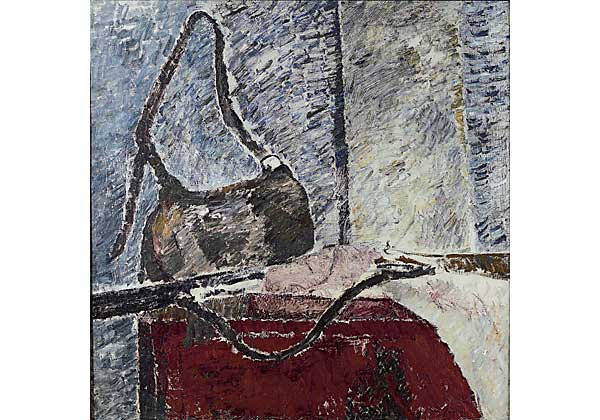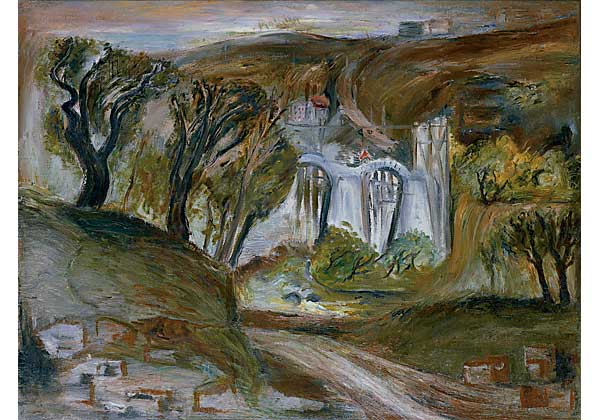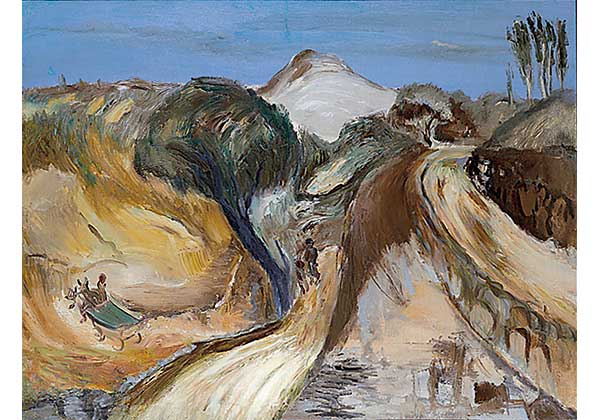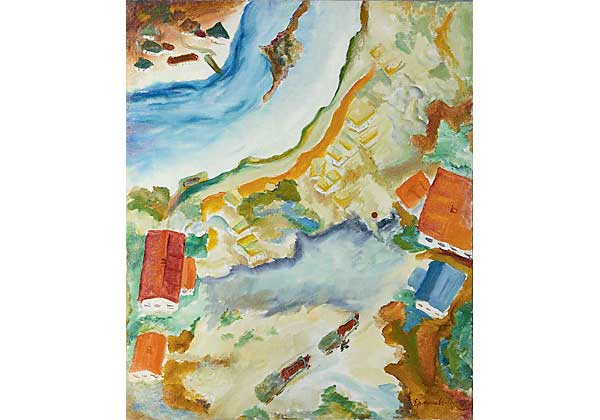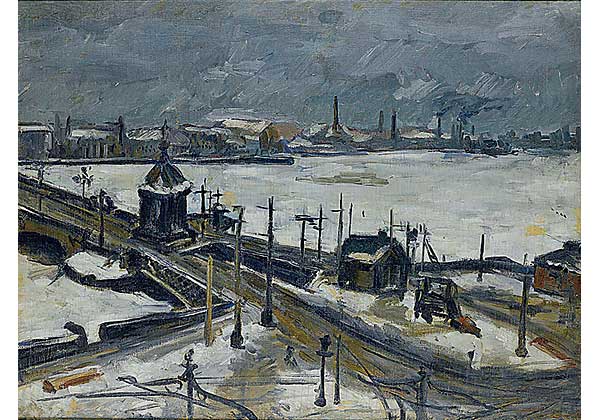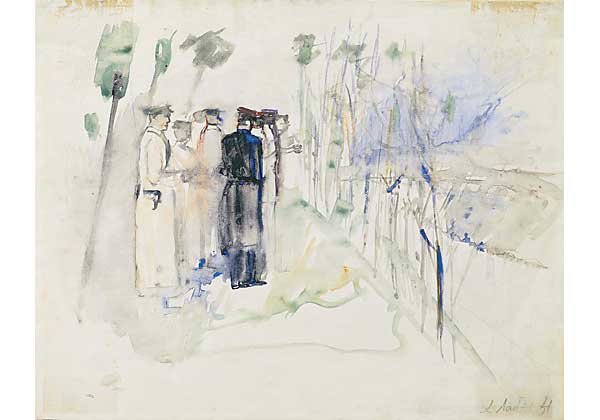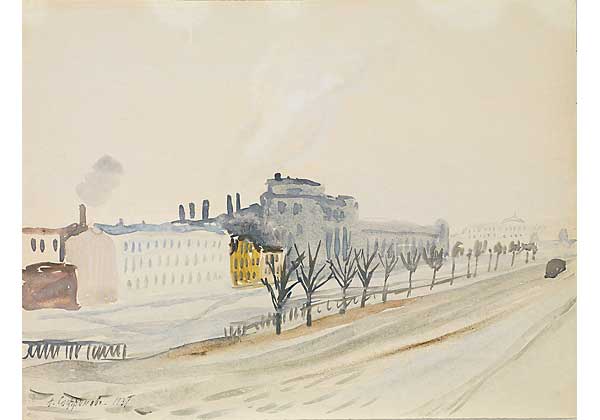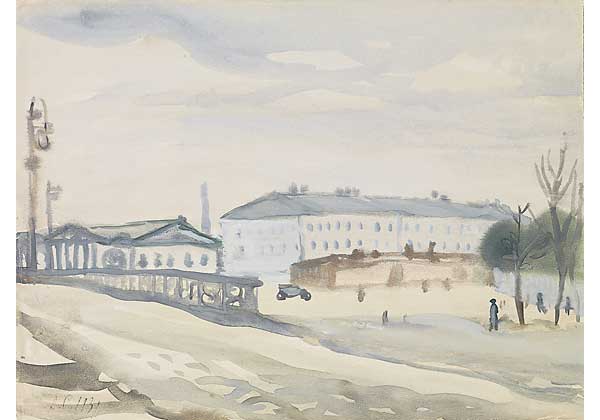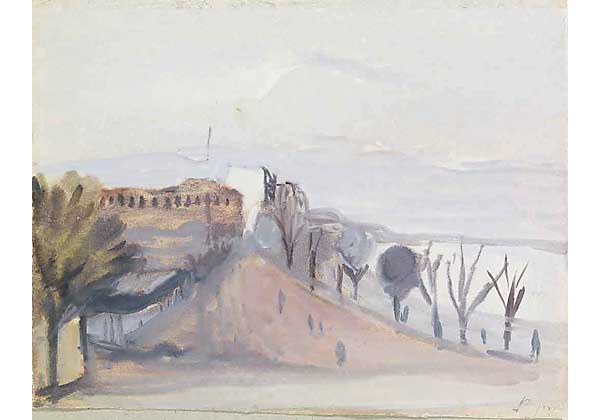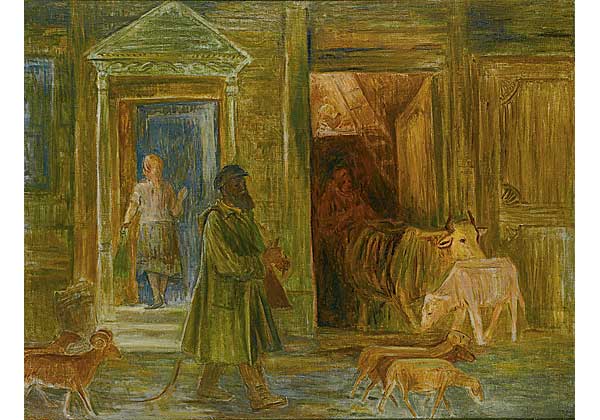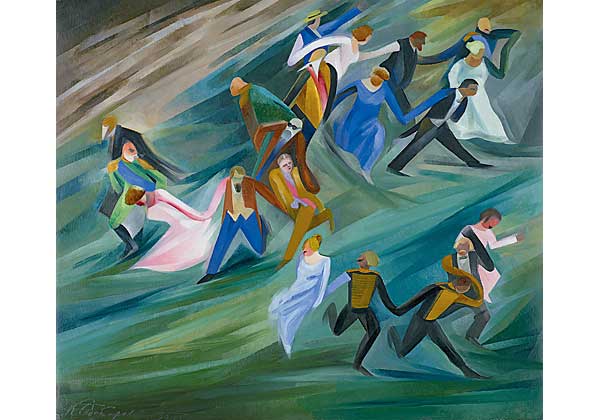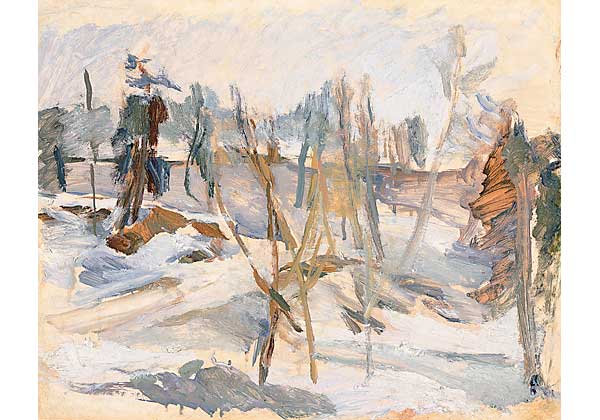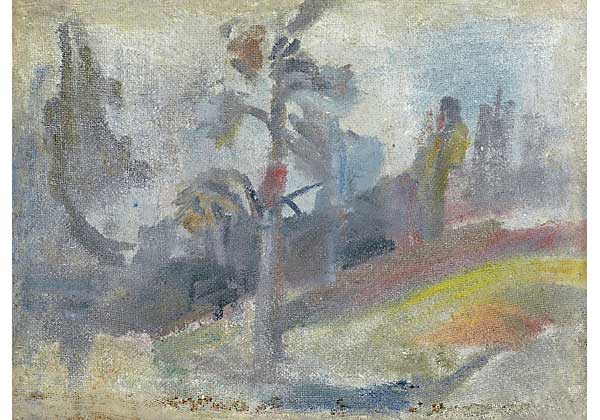Consulting UniCredit Bank
-
Vereisky Georgy Semyonovich
(b. 1886 Proskurov, Podolsk guberniya – d. 1962 Leningrad)
Graphic artist, etcher, lithographer
1895–1904 – Attended the studio of Ye. Shreider in Kharkov.
1905 – Began law studies at Kharkov University. Later that year, visited Germany, Austria, and Italy.
1912 – Graduated from university.
1913–1916 – Studied at the New Art Studios in St. Petersburg under M. Dobuzhinsky, B. Kustodiev, A. Ostroumova-Lebedeva, Ye. Lansere. Took part in exhibitions beginning in 1904. Member of the World of Art and Four Arts societies.
1918–1921 – Assistant curator of the Hermitage’s engravings collection.
1921–1930 – Curator of the above-mentioned collection.
1918–1919 – Taught at Baron Shtiglitz’s Central School of Technical Drawing in St. Petersburg and the Higher Photography and Photo Technique Institute.
1921–1923 – Taught at the Academy of Arts, and served as professor at Vkhutemas [Higher Art and Technical Studios] in Petrograd.
1922–1926 – Published five albums of lithographic portraits of famous artists.
1924 – Published The Village, an album of autolithography.
1949 – Elected full member of the Academy of Arts of the USSR.
1958 – Awarded a bronze medal at the Brussels World’s Fair.
He did not collect art as a professional collector does, rating works of art on the basis of their value and fame. Rather, he collected only that which served to meet his work-related needs at the present time, only the works of those artists who interested him at the given moment.
And so, for many years my father dreamt of obtaining a lithographic impression of Serov’s portrait of Leonid Andreyev. Was worried about the result, could not sleep. He impatiently flipped through a monograph on Serov in which this very rare lithograph could be found. When he finally saw this magnificent page with his own eyes, he was overjoyed. He even seemed to have gotten somewhat younger, and came up with the following topic for a short story:
“Some author ought to write about an eccentric man who has spent half a lifetime in search of a work of art which is supposed to make him young and strong again. The man overcomes tremendous difficulties, fails time and time again, and goes from hope to despair. But when fate smiles upon him and grants him what he has been searching for, he is already so old and frail that he dies from the shock!”
Orest Vereisky, “Reminiscences about My Father”
Georgy Semyonovich Vereisky. Katalog vystavki k 100-letiyu so dnya rozhdeniya [catalogue of Exhibition Devoted to His 100th Birthday]. M.: lzobrazitelnoye iskusstvo, 1986. P. 5.
(1886, г. Проскуров Подольской губ. — 1962, Ленинград)
График, гравер, литограф
1895-1904 посещал студию Е. Шрейдера в Харькове.
1905 поступил на юридический факультет Харьковского университета. В том же году уехал за границу, посетил Германию,Австрию, Италию.
1912 закончил университет.
1913-1916 занимался в Новой художественной мастерской в Петербурге у М. Добужинского, Б. Кустодиева, А. Остроумовой-Лебедевой, Е. Лансере.
С 1904 участник выставок. Член обществ «Мир искусства» и «4 искусства».
1918-1921 помощник хранителя отделения гравюр Эрмитажа, 1921-1930 хранитель того же отделения.
1918 — 1919 преподавал в Центральном училище технического рисования барона А. Штиглица в Петербурге, Высшем институте фотографии и фототехники, 1921 — 1923 — в Академии художеств, профессор Вхутемаса в Петрограде.
1922 — 1926 выпустил пять альбомов литографированных портретов деятелей искусств.
1924 — альбом автолитографий «Деревня».
1949 избран действительным членом Академии художеств СССР.
1958 награжден бронзовой медалью Всемирной выставки в Брюсселе.
Коллекционировал он не как профессионал-коллекционер, который собирает произведения искусства, руководствуясь их ценностью и известностью.
Он собирал только то, что в это время особенно отвечало его сегодняшним задачам в работе, только произведения художников, увлекавших его в данный момент.
Так, много лет отец мечтал получить литографский оттиск серовского портрета Леонида Андреева. Страшно волновался, удастся ли, не спал ночей. Нетерпеливо листал монографию о Серове, где эта очень редкая литография воспроизведена.
Наконец, когда он стал обладателем этого действительно великолепного листа, восторгам не было конца. Казалось, он помолодел. Он даже придумал сюжет для рассказа: «Вот бы кго-нибудь из писателей написал про чудака, половину жизни посвятившего поискам произведения искусства, которое должно придать ему сил, сделать его вновь молодым.
Он преодолевает страшные препятствия, терпит неудачи, переходит от надежды к отчаянию. Но когда судьба дарует ему желаемое, он уже немощен и стар и погибает, не в силах перенести это потрясение!»
Георгий Семенович Верейский. Каталог выставки к 1ОО-летию со дня рождения. М. Изобразительное искусство, 1986. c. 5.
-
Still Life with Hunter's Bag and Rifle
artist:Udaltsova, Nadezhda Andreyevna technique:Oil on canvas size:96,5 х 96,5 year: 1922Udaltsova, Nadezhda Andreyevna
(b. 1886 Oryol – d. 1961 Moscow)
Painter and graphic artist
1905–1908 – Took drawing and painting classes from K. Yuon and I. Dudin (N. UIyanov also taught there).
1909–1911 – Studied at private studios, including the studio of K. Kish in Moscow.
1912–1913 – Continued her artistic education at La Palette Academy in Paris under Jean Metzinger, Henri Le Fauconnier and Dunoyer de Segonzac.
1913 – Worked in V. Tatlin’s Tower Studio in Moscow.
Took part in exhibitions beginning in 1914, including: 1914 – Jack of Diamonds; 1915 – Tram V and Left Trends; 1915–1916 – Exhibition 0.10; 1916 – The Shop; 1921–1922 – World of Art; 1925 – Moscow Painters; 1931 – Thirteen group.
1916 – A member of the Supremus Artists’ group.
1918 – Assistant to K. Malevich.
1918–1920 – Taught at the First State Free Art Studios.
1920–1930 – Taught at Vkhutemas-Vkhutein [Higher Art and Technical Studios and Institute].
1930–1932 – Worked at the Moscow Textile Institute.
1932–1934 – Worked at the Moscow Polygraphic Institute.
Our critics are like stockbrokers who speculate on a rise or a fall. Critics play with our names in the same way, and in reality give nothing to the art, to the public or to the artists themselves. People who have compromised themselves, who have been proven ignorant in questions of art time and again, hold senior positions in magazines and affect the minds of the reading public. Muscovites can understand matters of art without the input of these articles, but people in the province are completely in the critics’ power and the harm they do is irreversible. <…> The conditions must be created in which artists under attack could defend their work.
Our critics are incapable of raising a single question dealing with modern art because most of them are old specialists, raised on Mir Iskusstva [World of Art] style, and Peredvizhniki (The Itinerants group); they can’t understand modern art and are only able to talk about “exact form.” Critics love to play hide-and-seek and for years on end ignore dozens of paintings that are on exhibition. Now, it was possible to do this in bourgeois society, where financial speculation was involved, but in our Soviet state such games are inadmissible. <…>
The goal of “a new realism” is right, and proletarian art is possible. It is dictated by life itself. Art in its essence is the People’s art; but the ruling classes made it serve themselves.
Real art is always close to the people and takes its images from the people and from nature.
Many critics have now come to the conclusion that modern art should be precise and graphic, without any nature at all. In reality, however, art can progress and abandon the old standards of AKhRR [The Association of Artists of Revolutionary Russia] and false styles of OST [The Society of Easel Painters] only by studying nature and life.
Nadezhda Udaltsova, “Response to ‘Our questionnaire among artists”
N.A. Udaitsova. Zhizn russkoy kubistiki. Dnevniki, statii, vospominaniya: Arkhiv russkogo avangarda [Life of Russian cubism. Diaries, articles, memoirs: Archive of the Russian avant-garde]. M.: Literaturno-hudozhestvennoye agentstvo RA, 1994. Pp. 69—70.
-
Woman for All Times
artist:Cherkes, Daniil Yakovlevich technique:Oil on canvas size:180 х 115 year: 1920sCherkes, Daniil Yakovlevich
(b. 1899 Moscow – d. 1971 Moscow)
Painter, graphic artist, director, animator, theater designer
1917 – Entered the Moscow University (Department of Physics and Math).
1918–1923 – Studied at Vkhutemas [Higher Art and Technical Studios]. Worked as a theater designer with Vsevolod Meyerhold, as a graphic artist in various publishing houses, and as a festivities decorator in Moscow and Nizhny Novgorod. Was one of the pioneers in the field of animated films.
1926 – Worked with a group of animators (Yu. Merkulov, I. Ivanov-Vano and others) at the Mezhrabpom-Rus film studio (known as Mezhrabpomfilm from 1928 on). Headed the studio’s animation department. Worked on creating advertisements and propaganda clips.
1927 – Debuted as a film director. Developed the so-called “album method” of animation together with I. Ivanov-Vano.
1930s – Worked at the Soyuzfilm studio (Moskinokombinat, Mosfilm).
Took part in exhibitions from 1933.
From 1935 on, devoted himself entirely to painting. Worked as a designer at the VSKhV [All-Union Agricultural Exhibition].
1941–1945 – Contributed to the TASS Windows propaganda posters.
But there is no longer a door. It is completely blocked up with broken pieces of the walls, with lumps and piles and heaps of glassy ice with red sparks. There is no way back, only forward. But where?
I, the Mother, I who live for a thousand cycles, I alone know where. I hear how we are hurtling towards Earth with a high-pitched whiz, a hundred times faster. Spinning; and everything is for this, and these last two, the man and the woman, have been fated to this by me. They are still alive, they are still people.
And I am a person. If I were not a person, if.. But I cannot say that aloud, and I know that I will smile at him now. There, I smiled…
“What did you do? What is that, the red thing over there?”
“That is Earth. I have turned towards Earth so that we… No, no, listen: there, on Earth, there is air. There are people, men and women, and they breathe all day long, all night long; they breathe as much as they want, and you don’t need to kill anymore there…
Yevgeny Zamyatin, “A Story about the Most Important Thing,” 1923
Ye. Zamyatin. Izbrannoe [Selected Works]. M.: Pravda, 1989 P. 220.
-
Winter Landscape
artist:Drevin, Alexander Davydovich technique:Oil on canvas size:83 х 70 year: 1924Drevin (Drevinsh), Alexander (Rudolf-Alexander) Davydovich
(b. 1889 Venden, Lifland guberniya – d. 1938 unknown location)
Painter, graphic artist
1908–1913 – Studied at the Riga City Art School under V. Purvit.
1915–1917 – Member of the Jack of Diamonds group.
1919 – Member of ASKRIN [The Association of Radical Innovators in Art].
Took part in exhibitions since 1912, including the 1922 exhibition of the World of Art society, the Moscow Painters exhibition in 1925, and the 1931 exhibition of the Thirteen group.
1927–1932 – Organizer and member of the Society of Moscow Artists.
1920–1930 – Taught at Vkhutemas-Vkhutein [Higher Art and Technical Studios and Institute]. Member of RAKhN-GAKhN [The Russian (later – State) Academy of Artistic Studies].
Repressed in 1938. Rehabilitated posthumously.
“What can an artist need more than to feel that you are getting your power from two tremendous sources: the power of life and the power of nature? 1922—1930: I spent all eight of these years getting one with nature as much as I possibly could. What always astounded me is that things don’t achieve what they are intended for. Not everything that you paint directly from nature is really a work of art; it became clear to me that I need to find some sort of secret to expression, and that in a way some work needs to be done in the artist himself. In 1930, I began to work seriously on this problem. I tried to paint the very same nature as before, but now in my studio. The strange thing is that it began to gradually be transformed into something else; nature disappeared, while the language of art became stronger and another reality began to be formed. That year, while in Armenia, I tried to join these two different approaches into a synthetic whole, and with great pleasure began to notice that the work was progressing. I worked directly from nature with a pencil, and found that my eye had achieved a degree of precision that I had not been aware of in myself earlier. Nevertheless, my previous work laid a sort of foundation for my painting activity.”
Alexander Drevin Tvorchestvo [Oeuvre], 1934. no. 4. Source: Khudozhniki gruppy Trinadtsat. Iz istorii khudozhestvennoy zhizni 1929—1930-kh gg. [The Artists of the Thirteen group: From the History of Art in the 1920s—1930s]. M.: Sovetsky Khudozhnik, 1985. P. 163.
-
Landscape with Railroad Bridge
artist:Drevin, Alexander Davydovich technique:Oil on canvas size:90 х 119,5 year: 1935Drevin (Drevinsh), Alexander (Rudolf-Alexander) Davydovich
(b. 1889 Venden, Lifland guberniya – d. 1938 unknown location)
Painter, graphic artist
1908–1913 – Studied at the Riga City Art School under V. Purvit.
1915–1917 – Member of the Jack of Diamonds group.
1919 – Member of ASKRIN [The Association of Radical Innovators in Art].
Took part in exhibitions since 1912, including the 1922 exhibition of the World of Art society, the Moscow Painters exhibition in 1925, and the 1931 exhibition of the Thirteen group.
1927–1932 – Organizer and member of the Society of Moscow Artists.
1920–1930 – Taught at Vkhutemas-Vkhutein [Higher Art and Technical Studios and Institute]. Member of RAKhN-GAKhN [The Russian (later – State) Academy of Artistic Studies].
Repressed in 1938. Rehabilitated posthumously.
“What can an artist need more than to feel that you are getting your power from two tremendous sources: the power of life and the power of nature? 1922—1930: I spent all eight of these years getting one with nature as much as I possibly could. What always astounded me is that things don’t achieve what they are intended for. Not everything that you paint directly from nature is really a work of art; it became clear to me that I need to find some sort of secret to expression, and that in a way some work needs to be done in the artist himself. In 1930, I began to work seriously on this problem. I tried to paint the very same nature as before, but now in my studio. The strange thing is that it began to gradually be transformed into something else; nature disappeared, while the language of art became stronger and another reality began to be formed. That year, while in Armenia, I tried to join these two different approaches into a synthetic whole, and with great pleasure began to notice that the work was progressing. I worked directly from nature with a pencil, and found that my eye had achieved a degree of precision that I had not been aware of in myself earlier. Nevertheless, my previous work laid a sort of foundation for my painting activity.”
Alexander Drevin Tvorchestvo [Oeuvre], 1934. no. 4. Source: Khudozhniki gruppy Trinadtsat. Iz istorii khudozhestvennoy zhizni 1929—1930-kh gg. [The Artists of the Thirteen group: From the History of Art in the 1920s—1930s]. M.: Sovetsky Khudozhnik, 1985. P. 163.
-
In the Mountains of Armenia
artist:Drevin, Alexander Davydovich technique:Oil on canvas size:91 х 120 year: 1933Drevin (Drevinsh), Alexander (Rudolf-Alexander) Davydovich
(b. 1889 Venden, Lifland guberniya – d. 1938 unknown location)
Painter, graphic artist
1908–1913 – Studied at the Riga City Art School under V. Purvit.
1915–1917 – Member of the Jack of Diamonds group.
1919 – Member of ASKRIN [The Association of Radical Innovators in Art].
Took part in exhibitions since 1912, including the 1922 exhibition of the World of Art society, the Moscow Painters exhibition in 1925, and the 1931 exhibition of the Thirteen group.
1927–1932 – Organizer and member of the Society of Moscow Artists.
1920–1930 – Taught at Vkhutemas-Vkhutein [Higher Art and Technical Studios and Institute]. Member of RAKhN-GAKhN [The Russian (later – State) Academy of Artistic Studies].
Repressed in 1938. Rehabilitated posthumously.
“What can an artist need more than to feel that you are getting your power from two tremendous sources: the power of life and the power of nature? 1922—1930: I spent all eight of these years getting one with nature as much as I possibly could. What always astounded me is that things don’t achieve what they are intended for. Not everything that you paint directly from nature is really a work of art; it became clear to me that I need to find some sort of secret to expression, and that in a way some work needs to be done in the artist himself. In 1930, I began to work seriously on this problem. I tried to paint the very same nature as before, but now in my studio. The strange thing is that it began to gradually be transformed into something else; nature disappeared, while the language of art became stronger and another reality began to be formed. That year, while in Armenia, I tried to join these two different approaches into a synthetic whole, and with great pleasure began to notice that the work was progressing. I worked directly from nature with a pencil, and found that my eye had achieved a degree of precision that I had not been aware of in myself earlier. Nevertheless, my previous work laid a sort of foundation for my painting activity.”
Alexander Drevin Tvorchestvo [Oeuvre], 1934. no. 4. Source: Khudozhniki gruppy Trinadtsat. Iz istorii khudozhestvennoy zhizni 1929—1930-kh gg. [The Artists of the Thirteen group: From the History of Art in the 1920s—1930s]. M.: Sovetsky Khudozhnik, 1985. P. 163.
-
Trees
artist:Yastrzhembsky, Anton Stanislavovich technique:Gouache on paper size:33 х 24,3 year: 1920sYastrzhembsky (Yastrzhemsky), Anton Stanislavovich
(b. 1884 Moscow — d. 1960 Moscow) Painter and graphic artist
1905—1913: Studied at the Moscow School of Painting, Sculpture and Architecture under A. Vasnetsov.
Took part in exhibitions beginning in 1910, including: 1910 — Union of Youth, Moscow; 1912 — Spring Salon; 1912 — Donkey’s Tail; 1913 — Target; 1916 — World of Art, Moscow; 1917 — World of Art, Petrograd.
1922 —1925: Member of the Makovets group.
1929: Member of the Society of Moscow Artists.
1933 — Member of the Russian Union of Artists.
Taught at Moscow Pedagogical Institute in 1910;
in 1919 — at the Studio of Painting and Drawing in Sokolniki, Moscow;
in 1921—1937 — at the State Free Art Studios in Nizhny Novgorod.
1922—1934: Director of the art department at the Museum of the Revolution and History.
1934—1937: Director of the Museum of Fine Arts in Nizhny Novgorod.
1938—1941 and 1943—1958: Taught at the Moscow Textile Institute (MTI).
“Art keeps the people’s wisdom that comes from ancient times and gives an artist the opportunity of expressing his personality creatively. Art should lead people to the high culture of knowledge and feeling, to participation in the creative process and the ability to evaluate and form an opinion. Art must fill life, giving it harmony and overall grace.
Therefore the most significant result that human actions are worth demand objective artistic creativity. If life and science study separate sources of existence, only art that is synthetically objective, takes from its full cup.
We objectively transfer the relations and the connection between things, representing them in exactly the same way people can understand them, and knowing that only by retaining its great objectivity an image will not lose its power despite all the variations of dark wanderings of individual feeling. By objectivity we do not mean impersonality or an impassive copy from nature, but the art that has passed through the creative crucible of its author. Our art originates from the passionate need of the soul that has to gather separate rays of sunshine, dispersed by the reflexive brain of contemporary life. We are witnessing the end of analytical art, and our task is to gather its separate elements into a powerful synthesis.
Vasily Chekrygin, “Our prologue (1921—1926)”
Makovets. 1922—1926. Sbornik materilov po istorii obiyedineniya [collection of Materials on the History of the Makovets Society: 1922—1926]. M., 1994. p. 55
-
Kamenka. View from Above
artist:Yermilova-Platova, Yefrosiniya Fedoseyevna technique:Oil on canvas size:85 х 71 year: 1925Yermilova-Platova, Yefrosiniya Fedoseyevna
(b. 1895 Village of Kamenka, Tavricheskaya guberniya – d. 1974 Moscow)
Painter, graphic artist
1914 – Entered the Moscow University (Department of History and Philology).
1914–1916 – Studied drawing under K. Yuon and I. Dudin.
1917–1918 – Attended I. Mashkov’s workshop.
1919 – Participated in the founding of an artistic studio, museum and poster workshop in Nikopol.
1919–1921 – Worked in the art section of the Crimean National Department of Education in Simferopol under Ya. Tugendhold.
Took part in exhibitions beginning in 1919, including: 1919 – exhibition of Kherson artists; 1932 – Artists of the RSFSR [Russian Soviet Federative Socialist Republic] During the Past 15 Years (Leningrad); 1934 – exhibition at the Club of Master Artists (Moscow) together with her husband, F. Platov; 1939, 1944 – personal exhibitions.
1949 – Expelled from the MOSKh [Moscow Artists’ Union].
1992 – posthumous personal exhibition at the Kuntsevo Exhibition Hall (Moscow).
“I don’t remember the exact year, but the exhibition by Goncharova, Larionov, and Burlyuk in Kherson left an indelible impression on my artwork for the rest of my life. I always really enjoyed primitivists such as Giotto, Pieter Bruegel, and contemporary French painters.”
The sources of her series of paintings Faces and Streets, At the Barber Shop, and Themes from Old Russian Frescoes are evident: folk painting, sign boards, popular prints, and icons. But these merely served as starting points for her work. c.> The unlimited fantasy, spontaneous self-expression, and organic primitivism of Yermilova-Platova sewed as a trustworthy antidote to the poison of stylization and even imitation. Her motto was “I paint everything I love.”
“In my childhood, I looked after flowers.” Flowers in the field and in the garden, exotic flowers, later became the dominant motif of her still lifes.
“The beauty of the Dnieper River has left its imprint on me for my entire life: its extraordinary high waters, riding in rowboats, sailboats and other small crafts into the city of Nikopol during both stormy and calm weather.” The word “imprint” seems to be very precise, for it is unlikely that Yermilova-Flatova painted her Kamenka-on-the-Dnieper scenes directly from life, year in, year out, in spring and in fall. It rather seems that she was traveling along the paths ingrained in her memory, again and again experiencing the feeling of being on the boundless waters or steppe, with the sky overhead. Her space is magnetic; it is made of “flying matter,” the condensation and dispersal of light, and is organized “by lines that express the crystal clarity of the details and a slightly indistinct landscape.” The artist’s ideal is “the Japanese linethat can be hard like metal and soft like down. It conveys a calm balance and a swift motion. The line is maintained both on the plane and in space.”
O. Roytenberg. Neuzheli kto-to vspomnit, chto my byli… Iz istorii khudozhestvennoy zhizni. 1925—1935 [Can It be that Someone Remembers that we Existed… From the History of Artistic Life: 1925—1935]. M.: Galart, 2004. Pp. 370, 372—373.
-
City View with a Bridge
artist:Zusman, Leonid Pavlovich technique:Oil on canvas size:100 х 140 year: 1926(b. 1906 Grodno – d. 1984 Moscow)
Painter and graphic artist
1919–1923 – Studied at the private studios of F. Rerberg and A. Miganadjian in Moscow and audited classes at the First State Free Art Studios under I. Mashkov.
1924–1926 – Studied at Vkhutein [The Higher Art and Technical Institute] in Leningrad under K. Petrov-Vodkin.
1927–1929 – Studied at Vkhutein in Moscow under D. Shterenberg.
Took part in exhibitions beginning in 1928, including: 1928 – Fourth Exhibition of Paintings, Drawings, and Sculpture by OST [Society for Easel Painting]; 1929 – USSR Art Exhibition in New York; 1931 – art exhibition in Paris; 1938 – the Soviet exhibition in London; 1966 – first personal exhibition in Moscow; 1978 – second personal exhibition in Moscow.
From 1931 on – Worked as a book illustrator and designer, designed stage scenery for theaters in Moscow, Kiev, Odessa, and Rybinsk.
From 1944 on – Worked on the TASS Windows propaganda posters, as well as in various publishing houses and as an art director of Vokrug Sveta [Around the World] magazine.
1959 – Awarded a silver medal at the Leipzig Book Fair for his work on In Praise of Folly by Erasmus of Rotterdam.
“The thought that a painting’s only value is in itself, is alien to me. I see its meaning in the images and associations it provokes; the more numerous and various they are, the more necessary the painting is. It also reflects the humans’ great community and continuity that is reflected in the very fact that we, people of the second half of the 20th century, who fly gigantic airplanes, travel in space and land on the Moon, can find pleasure in a simple and beautiful sight of a plate filled with peaches with tender velvety skin, with shades of pink and blue, or a white jar with blue ornaments and a bouquet of flowers — the same sight that might have delighted an artist who lived three centuries ago, wore a powdered wig and silk trousers, believed in God and honoured his King.”
Leonid Zusman, 1978
S.I. Balashov. Leonid Zusman. M.: Agey Tomesh, 2004. P. 16. (Novaya istoriya iskusstva [New History of Art]).
-
From the Cycle At Maneuvers
artist:Labas, Alexander Arkadievich technique:Watercolors on paper size:27 х 34 year: 1931Labas, Alexander Arkadievich
(b. 1900 Smolensk – d. 1983 Moscow)
Painter, graphic artist and theater designer
1907–1908 – Studied at the studio of V. Mushketov in Smolensk.
1912– 1917 – Studied at Moscow Stroganov Higher College of Art and Industry under S. Noakovsky, F. Fyodorovsky and D. Shcherbinovsky, and at the same time at the studios of F. Rerberg and I. Mashkov.
1918 – Entered SVOMAS [The State Free Art Studios] in Moscow under P. Konchalovsky and F. Malyavin. Took part in exhibitions beginning in 1921, including: 1929 – USSR Art Exhibitions in New York, Philadelphia, Boston and Detroit; 1937 – the World Fair in Paris; 1939 – the International Exhibition in New York; 1976 – personal exhibition
in Moscow.
1925–1932 – Co-founder and member of OST [Society for Easel Painting].
1920–1921 – Taught painting at the State Art Studios in Yekaterinburg.
1924–1929 – Taught painting and chromatics at Vkhutemas-Vkhutein [The Higher Art and Technical Studios and Institute] in Moscow.
1930s – Worked on panoramic and dioramic designs and theater scenery.
“I would like to live to the year 2000, but only if I could retain the ability to see, to feel, and to experience, which is already very difficult, almost impossible. But I’d like to at least dream of living through the entire 20th century, the most wonderful century ever, a century full of astounding discoveries and revolutions in life, science, technology, and art. And all this happened right before my eyes. Everything was a real experience, and I participated in much of it myself What I’m sure of is this: with every coming decade, my work will be better and better understood, and in, say, 50 or 100 years, it will ring out at flail strength. Everyone will see in my work our own time; I think I perceived it very well and was able to discern the meaning of the very complicated events of our breathtaking 20th century. I was born at an amazingly precise time: this century fits me like no other century.”
Alexander Labas, Moscow, 1980s
Gossudarstvennyi Russky muzei predstavlyaet: Aleksandr Labas. Vospominaniya [The state Russian Museum Presents: Alexander Labas. Memoirs] /Almanakh [Almanac], no. 86. SPb.: Palace Editions, 2004. P. 123.
-
Moskva River Embankment by the MOGES (Moscow State Powerplant)
artist:Sofronova, Antonina Fyodorovna technique:Gouache on paper size:30,8 х 41 year: 1931Sofronova (Safronova), Antonina Fyodorovna
(b. 1892 Village of Droskovo, Oryol guberniya – d. 1966 Moscow)
Painter and graphic artist
1910–1913 – Studied in Moscow at the studio of F. Rerberg.
1913–1917 – At I. Mashkov’s studio.
1920–1921 – Taught at the State Free Art Studios in Tver. Author of several articles on the theory of new art.
Took part in exhibitions beginning in 1914, including: 1914 – the Jack of Diamonds group; 1917 – the World of Art group and the Moscow Association of Artists; 1925 – the International Exhibition of Modern Decorative and Industrial Arts in Paris; 1931 – the Thirteen group; 1962 – personal exhibition in Moscow’s Central House of Writers.
1923 – Designed the cover for Nikolai Tarabukin’s book From Easel to Machine.
1931 – Member of the Thirteen group.
“Since 1926 [Sofronova] began painting scenes of Moscow in oil. She loved to walk down Moscow’s streets and frequently took promenades along the Moskva River. All of these places were not far from where she lived, in BolshoyAfanasyevsky Lane, located between the Arbat and Prechistenka Street. <…> As Sofronova strolled along, she would make little sketches with faint pencil marks and indications of color, or sometimes simply remembered what she saw — she had practiced this hard while living in Droskovo. Returning home, she would paint the scene preliminarily in watercolors with whitewash (eventually producing a series of such paintings). In selecting which motifs of the city to paint, Sofronova was mostly attracted to those views which had a receding line. For example, she loved to paint riverfronts, city streets, and alley sidewalks. Her paintings were spacious, with lots of sky, river views, and trees with sparse foliage; the light was soft, with no sharply defined shadows.”
Irina Yevstafieva, Antonina Sofronova
Khudozhniki gruppy Trinadtsat. Iz istorii khudozhestvennoy zhizni 1920-1930-kh gg. [The Artists of the Thirteen group: From the History of Art in the 1920s—1930s]. M.: Sovetsky Khudozhnik, 1985. P. 193.
-
Square by Kamenny Bridge
artist:Sofronova, Antonina Fyodorovna technique:Gouache on paper size:30,7 х 41,4 year: 1931Sofronova (Safronova), Antonina Fyodorovna
(b. 1892 Village of Droskovo, Oryol guberniya – d. 1966 Moscow)
Painter and graphic artist
1910–1913 – Studied in Moscow at the studio of F. Rerberg.
1913–1917 – At I. Mashkov’s studio.
1920–1921 – Taught at the State Free Art Studios in Tver. Author of several articles on the theory of new art.
Took part in exhibitions beginning in 1914, including: 1914 – the Jack of Diamonds group; 1917 – the World of Art group and the Moscow Association of Artists; 1925 – the International Exhibition of Modern Decorative and Industrial Arts in Paris; 1931 – the Thirteen group; 1962 – personal exhibition in Moscow’s Central House of Writers.
1923 – Designed the cover for Nikolai Tarabukin’s book From Easel to Machine.
1931 – Member of the Thirteen group.
“Since 1926 [Sofronova] began painting scenes of Moscow in oil. She loved to walk down Moscow’s streets and frequently took promenades along the Moskva River. All of these places were not far from where she lived, in BolshoyAfanasyevsky Lane, located between the Arbat and Prechistenka Street. <…> As Sofronova strolled along, she would make little sketches with faint pencil marks and indications of color, or sometimes simply remembered what she saw — she had practiced this hard while living in Droskovo. Returning home, she would paint the scene preliminarily in watercolors with whitewash (eventually producing a series of such paintings). In selecting which motifs of the city to paint, Sofronova was mostly attracted to those views which had a receding line. For example, she loved to paint riverfronts, city streets, and alley sidewalks. Her paintings were spacious, with lots of sky, river views, and trees with sparse foliage; the light was soft, with no sharply defined shadows.”
Irina Yevstafieva, Antonina Sofronova
Khudozhniki gruppy Trinadtsat. Iz istorii khudozhestvennoy zhizni 1920-1930-kh gg. [The Artists of the Thirteen group: From the History of Art in the 1920s—1930s]. M.: Sovetsky Khudozhnik, 1985. P. 193.
-
Moskva River Embankment
artist:Sofronova, Antonina Fyodorovna technique:Gouache on paper size:31,3 х 40 year: 1931Sofronova (Safronova), Antonina Fyodorovna
(b. 1892 Village of Droskovo, Oryol guberniya – d. 1966 Moscow)
Painter and graphic artist
1910–1913 – Studied in Moscow at the studio of F. Rerberg.
1913–1917 – At I. Mashkov’s studio.
1920–1921 – Taught at the State Free Art Studios in Tver. Author of several articles on the theory of new art.
Took part in exhibitions beginning in 1914, including: 1914 – the Jack of Diamonds group; 1917 – the World of Art group and the Moscow Association of Artists; 1925 – the International Exhibition of Modern Decorative and Industrial Arts in Paris; 1931 – the Thirteen group; 1962 – personal exhibition in Moscow’s Central House of Writers.
1923 – Designed the cover for Nikolai Tarabukin’s book From Easel to Machine.
1931 – Member of the Thirteen group.
“Since 1926 [Sofronova] began painting scenes of Moscow in oil. She loved to walk down Moscow’s streets and frequently took promenades along the Moskva River. All of these places were not far from where she lived, in BolshoyAfanasyevsky Lane, located between the Arbat and Prechistenka Street. <…> As Sofronova strolled along, she would make little sketches with faint pencil marks and indications of color, or sometimes simply remembered what she saw — she had practiced this hard while living in Droskovo. Returning home, she would paint the scene preliminarily in watercolors with whitewash (eventually producing a series of such paintings). In selecting which motifs of the city to paint, Sofronova was mostly attracted to those views which had a receding line. For example, she loved to paint riverfronts, city streets, and alley sidewalks. Her paintings were spacious, with lots of sky, river views, and trees with sparse foliage; the light was soft, with no sharply defined shadows.”
Irina Yevstafieva, Antonina Sofronova
Khudozhniki gruppy Trinadtsat. Iz istorii khudozhestvennoy zhizni 1920-1930-kh gg. [The Artists of the Thirteen group: From the History of Art in the 1920s—1930s]. M.: Sovetsky Khudozhnik, 1985. P. 193.
-
Shchipitsyn, Alexander Vasilievich
(b. 1897 Nizhny Novgorod – d. 1943 Moscow)
Painter
1921–1925 – Studied at Nizhny Novgorod State Art School under A. Kuprin.
1925–1930 – Studied at Vkhutemas-Vkhutein [Higher Art and Technical Studios and Institute] under A. Drevin, R. Falk, and D. Shterenberg.
1929–1932 – Participated in V. Tatlin’s work constructing the famous Letatlin human-powered flight machine in Tatlin’s studio in the tower of Novodevichy Convent.
Took part in exhibitions beginning in 1929. Member of the Growth group, OST [The Society of Easel Painting] and RAPKh [The Russian Association of Proletarian Artists].
“I never personally witnessed Shchipitsyn in the process of painting, but my father, who considered him to be a master painter, used to recount how Shchipitsyn worked. He did not paint from life, so he did not turn to the brush every day, but would take time to think things through. Whenever he came to a decision about how he wanted to paint something, he would put a stool and an easel with a clean canvas in the middle of the room. On the stool he would place a palette and a box of paints. This way, he would have to encounter the stool and step over it each time he walked from the door to the table or vice versa. Thus, the paints and canvas forced him to start working because they interfered with his movement around the room. From that moment on, he would disappear for a week or maybe ten days. Our family knew that he was engaged in his work. He would complete his painting in that time frame and almost never return to it again.Shchipitsyn’s palette was small, polished and clean. He loved to paint using round sable-hair brushes. He would first paint with thick paints, rubbing them into the primed canvas, and then would glaze them over. He was very careful with his paints, as were the master painters of old. He never squeezed all of the colours out onto the palette together in advance, but only as he had need of each one. He couldn’t stand it when the paints were mixed together indiscriminately. Shchipitsyn had studied under Vladimir Yevgrafovich Tatlin and shared Tatlin’s understanding of materials. He usually primed his canvases himself, although some of his works are painted on French pre-primed canvases. Sometimes he would add wax to his paints.”
Sofia Zelenskaya
“Alexander Vasilievich Shchipitsyn. 1896—1943.” Katalog [calaloguel. M.: Sovetsky Khudozhnik, 1982. Pp. 8, 10.
-
Tsar's Courtiers
artist:Chebotarev, Konstantin Konstantinovich technique:Oil on paper size:37,9 х 44,1 year: 1935Chebotarev, Konstantin Konstantinovich
(b. 1892 Yurminsk, Ufa guberniya – d. 1974 Moscow)
Painter, graphic artist and theater designer
1910–1917 – Studied at Kazan Art School.
1922 – Graduated from Kazan Higher Artistic and Technical Institute.
1918 – Organized the Sunflower group of artists in Kazan.
Took part in exhibitions beginning in 1914, including the 2nd Exhibition of Laboratory and Industrial Works produced by the Left Front of the Arts (LEF) in Kazan in 1925.
1921–1926 – Taught at Kazan Higher Institute for Art and Industry.
1923–1926 – Worked at KEMST [The Kazan Experimental Studios of Modern Theater].
Worked in Moscow from 1926 on.
“Once upon a time in a faraway kingdom there lived a king and another fellow. At first everything was fine. They fished together, and whenever there was any drinking, they were the first to join in.
If the king took a glass in his hand, that fellow took a glass as well. The fellow’s name was Kapiton. He even lived next door to the king.
One autumn they return from the sea, and the king goes to call on his most important lords. This Kapiton fellow follows after the king. His Majesty didn’t like this. It was not an acceptable thing to do.
Once the king was invited to a banquet at the chief Senator’s house. There was a big table with plenty to eat and drink, and the ladies-in-waiting were singing songs. The king was showing off in a corner with a glass of vodka in one hand and his other arm around a lady-in-waiting’s waist. His crown was crooked, and he had taken off his uniform and was sitting in only his vest. He was also happy that his friend was nowhere near.
As the feast was coming to an end, the wine went to Queen Agrafena’s head most of all. And as soon as her adjutant Korolyov began to play the accordion, she went to the center of the hail and started dancing…”
Boris Shergin, “The Gilded Foreheads”
B.V. Shergin. Veseliye serdechnoe IHearty Merriment]. M.:OGI, 2006. P. 200.
-
Once upon a Time in a Faraway Kingdom There Lived a King and Another Fellow...
artist:Chebotarev, Konstantin Konstantinovich technique:Oil on paper size:38,1 х 44,3 year: 1935Chebotarev, Konstantin Konstantinovich
(b. 1892 Yurminsk, Ufa guberniya – d. 1974 Moscow)
Painter, graphic artist and theater designer
1910–1917 – Studied at Kazan Art School.
1922 – Graduated from Kazan Higher Artistic and Technical Institute.
1918 – Organized the Sunflower group of artists in Kazan.
Took part in exhibitions beginning in 1914, including the 2nd Exhibition of Laboratory and Industrial Works produced by the Left Front of the Arts (LEF) in Kazan in 1925.
1921–1926 – Taught at Kazan Higher Institute for Art and Industry.
1923–1926 – Worked at KEMST [The Kazan Experimental Studios of Modern Theater].
Worked in Moscow from 1926 on.
“Once upon a time in a faraway kingdom there lived a king and another fellow. At first everything was fine. They fished together, and whenever there was any drinking, they were the first to join in.
If the king took a glass in his hand, that fellow took a glass as well. The fellow’s name was Kapiton. He even lived next door to the king.
One autumn they return from the sea, and the king goes to call on his most important lords. This Kapiton fellow follows after the king. His Majesty didn’t like this. It was not an acceptable thing to do.
Once the king was invited to a banquet at the chief Senator’s house. There was a big table with plenty to eat and drink, and the ladies-in-waiting were singing songs. The king was showing off in a corner with a glass of vodka in one hand and his other arm around a lady-in-waiting’s waist. His crown was crooked, and he had taken off his uniform and was sitting in only his vest. He was also happy that his friend was nowhere near.
As the feast was coming to an end, the wine went to Queen Agrafena’s head most of all. And as soon as her adjutant Korolyov began to play the accordion, she went to the center of the hail and started dancing…”
Boris Shergin, “The Gilded Foreheads”
B.V. Shergin. Veseliye serdechnoe IHearty Merriment]. M.:OGI, 2006. P. 200.
-
-
Koroteyev, Vasily Andreyevich
(b. 1906 Village of Grishino (Krasnoarmeysk), Ukraine – d. 1969 Moscow)
Painter and graphic artist
1920–1925 – Studied at the State Typography School attached to the First Model Printshop under S. Gerasimov, M. Dobrov, L. Zhegin, M. Rodionov and N. Chernyshov in Moscow.
1925–1932 – Chromolithograph artist at the same printshop.
1926–1930 – Member of the Path of Painting group.
Took part in exhibitions beginning in 1927, including: 1927 – 1st Exhibition of Paintings and Drawings by Path of Painting, Moscow; 1928 – Path of Painting exhibition in Paris; 1930 – 2nd Exhibition of Paintings and Drawings by Path of Painting in Moscow; 1958 – Art Exhibition of industrial and technical studios at VSKhV [All-Union Agricultural Exhibition; later renamed VDNKh (The Exhibition of Achievements of the National Economy)], Moscow.
Later worked as an artist and designer at the Moscow Sculpture Factory, CPKiO [Gorky Central Park of Culture and Rest] Open Air Theatre, and the Museums of History and Anthropology.
1953–1966 – Worked at VDNKh.
“He [Pavel Florensky] paid a visit to the small Path of Painting exhibition which we had set up in a private flat at Serehryanny Lane. This was in 1927. Florensky did not like the works of my friend P. Babichev, finding them to be too impressionistic, whereas he himself strove for greater structuralism. “Everything is drifting here,” he noted. I could in no way agree with his evaluation. In my eyes, Bahichev was of course a painter, and this meant that he knew how to organize forms.
Then Florensky examined a work by V. Koroteyev — a full-sized female figure painted in beautiful colours. He pointed out the originality and consistency of the colour scheme: the entire body was of a very light brownish-pink hue, while the head was light green. Plorensky explained that the body is the expression of the sex, whereas the head relates to a completely different realm, and that this difference was expressed with the colours: green dematerializes and ties into intellect, which is the realm of the head.
Lev Zhegin, “Memories of P.A. Florensky”
Makovets. 1922—1926. Sbornik materialov po istorii obyedineniya [Collection of Materials on the History of the Makovets society: 1922—1 926]. M., 1994. P. 101.
-
Koroteyev, Vasily Andreyevich
(b. 1906 Village of Grishino (Krasnoarmeysk), Ukraine – d. 1969 Moscow)
Painter and graphic artist
1920–1925 – Studied at the State Typography School attached to the First Model Printshop under S. Gerasimov, M. Dobrov, L. Zhegin, M. Rodionov and N. Chernyshov in Moscow.
1925–1932 – Chromolithograph artist at the same printshop.
1926–1930 – Member of the Path of Painting group.
Took part in exhibitions beginning in 1927, including: 1927 – 1st Exhibition of Paintings and Drawings by Path of Painting, Moscow; 1928 – Path of Painting exhibition in Paris; 1930 – 2nd Exhibition of Paintings and Drawings by Path of Painting in Moscow; 1958 – Art Exhibition of industrial and technical studios at VSKhV [All-Union Agricultural Exhibition; later renamed VDNKh (The Exhibition of Achievements of the National Economy)], Moscow.
Later worked as an artist and designer at the Moscow Sculpture Factory, CPKiO [Gorky Central Park of Culture and Rest] Open Air Theatre, and the Museums of History and Anthropology.
1953–1966 – Worked at VDNKh.
“He [Pavel Florensky] paid a visit to the small Path of Painting exhibition which we had set up in a private flat at Serehryanny Lane. This was in 1927. Florensky did not like the works of my friend P. Babichev, finding them to be too impressionistic, whereas he himself strove for greater structuralism. “Everything is drifting here,” he noted. I could in no way agree with his evaluation. In my eyes, Bahichev was of course a painter, and this meant that he knew how to organize forms.
Then Florensky examined a work by V. Koroteyev — a full-sized female figure painted in beautiful colours. He pointed out the originality and consistency of the colour scheme: the entire body was of a very light brownish-pink hue, while the head was light green. Plorensky explained that the body is the expression of the sex, whereas the head relates to a completely different realm, and that this difference was expressed with the colours: green dematerializes and ties into intellect, which is the realm of the head.
Lev Zhegin, “Memories of P.A. Florensky”
Makovets. 1922—1926. Sbornik materialov po istorii obyedineniya [Collection of Materials on the History of the Makovets society: 1922—1 926]. M., 1994. P. 101.

